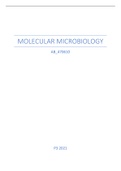Class notes
Molecular Microbiology AB_470610 Complete Summary
- Course
- Institution
This summary is very complete and detailed about the content of the course Molecular Microbiology AB_. With this summary you do not need to worry about the exam :) I scored an 8.8 on the exam by using this summary with ease. Good luck on the exam!
[Show more]



